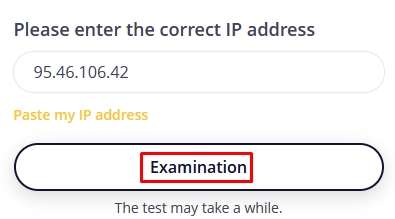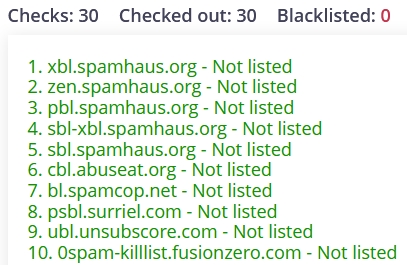IPv4
From $0.72 for 1 pc. 37 countries to choose from, rental period from 7 days.
IPv4
From $0.72 for 1 pc. 37 countries to choose from, rental period from 7 days.
IPv4
From $0.72 for 1 pc. 37 countries to choose from, rental period from 7 days.
IPv6
From $0.07 for 1 pc. 14 countries to choose from, rental period from 7 days.
ISP
From $1.35 for 1 pc. 23 countries to choose from, rental period from 7 days.
Mobile
From $14 for 1 pc. 20 countries to choose from, rental period from 2 days.
Resident
From $0.70 for 1 GB. 200+ countries to choose from, rental period from 30 days.
Use cases:
Use cases:
Tools:
Company:
About Us:
Having connection problems when trying to access certain websites, logging into a CRM, sending emails, or receiving unexpected access denial messages may signal that your address is blacklisted. This problem often occurs, particularly with public proxy servers. To resolve the issue, the first step is to check IP address blacklist against known spam databases.
In this case, we will explain what to do when your IP address is blocked, why it happens, and how to prevent similar issues in the future.
In order to check IP for blacklist, there are services that can scan multiple databases for you.
One of the simplest options is the free “Checker Tool” that helps to check if an IP address is in blacklist against more than 30 known spam databases, including Spamhaus, UCEPROTECT, SORBS, among others.
Here's how to use it:



The processing time for requests is minimal, making this tool quick and easy to use for beginners.
The most common reason would be an address’s reputation that a user inherits – especially true if it came from free public pools. Its reputation is derived from online activity concerning the address. If an address has engaged in questionable dealings, it is likely to have a low reputation.
Therefore, if you are new to using an address and you find it is already flagged, then it is quite likely that a previous user has damaged its reputation. Even if you are using it now for proper reasons, a lot of websites or services may still see it as a potential risk.
But there is also another cases where, initially, checking the IP against spam databases returned a clean result and everything worked stably, but over time, issues began to occur, for example:
A follow-up query to the block-lists shows the address still logged as undesirable traffic. When a proxy is shared among multiple users, one errant occupant might send spam or scrape content enormously, and that abuse then settles on the entire pool. You inherit the damage regardless of your own intentions.
There’s also such a scenario — when the issue stems from the user’s own actions. Beginners sometimes hammer a target with requests that easily exceed any reasonable throttle, whether they are mining data or blasting out bulk requests.
In every instance the root remains the same, and knowing the action-sets that invite a block saves everyone time, money, and the hassle of an instant ban.
Here are some most relevant pointers:
After determining the relevant causes, the subsequent step is identifying how to unblock a blacklisted address.
Imagine a scenario in which a check shows that your proxy has been blacklisted. The most important thing here is to understand that replacing the IP is far simpler and quicker than attempting to rectify the situation in most cases.
If you utilize a proxy server from a public pool, remember that no one will take the time to manage the reputation of these addresses individually. In such situations, it is better to go with a private solution.
If you are encountering these problems while using shared proxies, it is advisable to switch to dedicated ones. This way, other users will not have the ability to affect your actions and the chances of getting blocked are greatly diminished.
Always go with service providers that are known for their reliability and actively take care of the quality of their services. Trusted providers actively maintain the reputational standing of their proxy IPs, blacklist those with negative reputation, and preemptively replace problem ones.
Another possible option is IPv6 proxies. Because these IPs are new and unused, they are not flagged in any spam databases.
They are optimal if you need to:
However, some sites and certain banks or corporate services with outdated systems that use IPv4 only might cause issues. It is best to confirm IPv6 compatibility before implementing such solutions.
Ordinary users do not have the ability to manually remove their IP from blacklists because that option is only available to the range owner. This would be a data center, hosting provider or internet operator. So, if you are renting proxy servers, all you can do is ask for a replacement.
Different providers have various approaches to IP blacklist removal online. They offering dedicated IPs usually check such addresses for status and reputation. Upon detection of a block, they:
With these providers, concerns about reputation can be dealt with swiftly and without client intervention.
On the other hand, users of free or public proxies face a different issue. These will continue to be offered for as long as they technically work. So, such IPs have the potential to stay blacklisted indefinitely due to their unreliable nature. They are only fit for simple operations.
Some providers do offer delisting upon request or promptly replace IPs for clients using dedicated solutions. While not a perfect control mechanism, this is sufficient for many use cases.
For this reason, it is advisable to look for a provider from the beginning which guarantees good service, thorough spam filtration, and proactive IP blacklist monitoring to completely avoid being added to it.
When employing proxy servers and facing limitations, it is likely that the IP address is blacklisted. This can be verified within a minute with online lookup services. However, unblocking it is not within your control but rather the entity that owns it.
Even though users cannot directly submit delisting requests, they have the ability to select a reliable provider that actively manages the reputation of its proxies, promptly replaces bad ones, and performs automated delisting on behalf of the client when needed.
To prevent re-blacklisting, use private proxies and test every new address before employing it. Another method of obtaining clean addresses is to use IPv6 proxies; however, make sure the target sites support the protocol prior to implementation.
